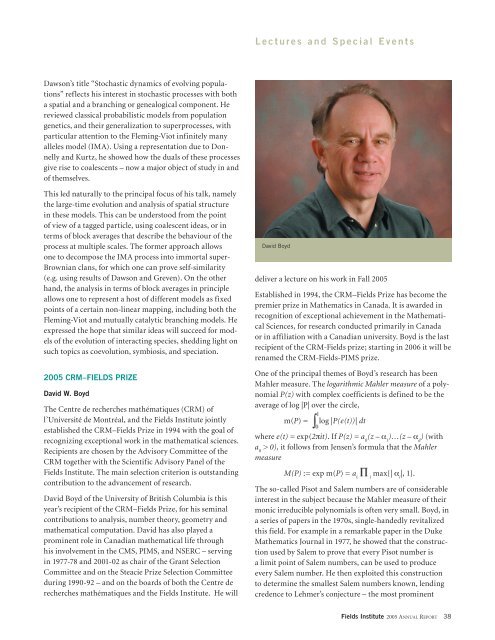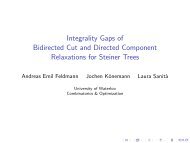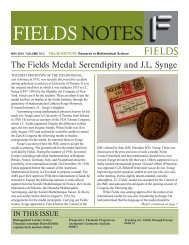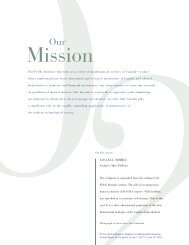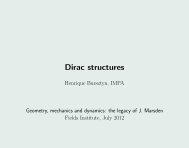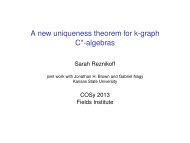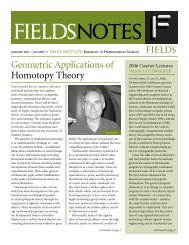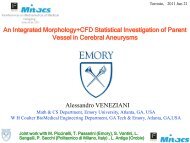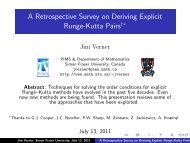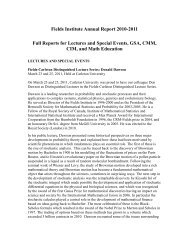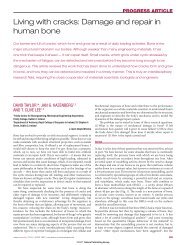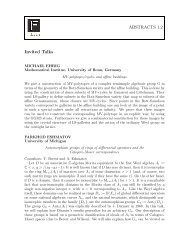Annual Report 2005 - Fields Institute - University of Toronto
Annual Report 2005 - Fields Institute - University of Toronto
Annual Report 2005 - Fields Institute - University of Toronto
Create successful ePaper yourself
Turn your PDF publications into a flip-book with our unique Google optimized e-Paper software.
Dawson’s title “Stochastic dynamics <strong>of</strong> evolving populations”<br />
reflects his interest in stochastic processes with both<br />
a spatial and a branching or genealogical component. He<br />
reviewed classical probabilistic models from population<br />
genetics, and their generalization to superprocesses, with<br />
particular attention to the Fleming-Viot infinitely many<br />
alleles model (IMA). Using a representation due to Donnelly<br />
and Kurtz, he showed how the duals <strong>of</strong> these processes<br />
give rise to coalescents – now a major object <strong>of</strong> study in and<br />
<strong>of</strong> themselves.<br />
This led naturally to the principal focus <strong>of</strong> his talk, namely<br />
the large-time evolution and analysis <strong>of</strong> spatial structure<br />
in these models. This can be understood from the point<br />
<strong>of</strong> view <strong>of</strong> a tagged particle, using coalescent ideas, or in<br />
terms <strong>of</strong> block averages that describe the behaviour <strong>of</strong> the<br />
process at multiple scales. The former approach allows<br />
one to decompose the IMA process into immortal super-<br />
Brownian clans, for which one can prove self-similarity<br />
(e.g. using results <strong>of</strong> Dawson and Greven). On the other<br />
hand, the analysis in terms <strong>of</strong> block averages in principle<br />
allows one to represent a host <strong>of</strong> different models as fixed<br />
points <strong>of</strong> a certain non-linear mapping, including both the<br />
Fleming-Viot and mutually catalytic branching models. He<br />
expressed the hope that similar ideas will succeed for models<br />
<strong>of</strong> the evolution <strong>of</strong> interacting species, shedding light on<br />
such topics as coevolution, symbiosis, and speciation.<br />
<strong>2005</strong> CRM–FIELDS PRIZE<br />
David W. Boyd<br />
The Centre de recherches mathématiques (CRM) <strong>of</strong><br />
l’Université de Montréal, and the <strong>Fields</strong> <strong>Institute</strong> jointly<br />
established the CRM–<strong>Fields</strong> Prize in 1994 with the goal <strong>of</strong><br />
recognizing exceptional work in the mathematical sciences.<br />
Recipients are chosen by the Advisory Committee <strong>of</strong> the<br />
CRM together with the Scientific Advisory Panel <strong>of</strong> the<br />
<strong>Fields</strong> <strong>Institute</strong>. The main selection criterion is outstanding<br />
contribution to the advancement <strong>of</strong> research.<br />
David Boyd <strong>of</strong> the <strong>University</strong> <strong>of</strong> British Columbia is this<br />
year’s recipient <strong>of</strong> the CRM–<strong>Fields</strong> Prize, for his seminal<br />
contributions to analysis, number theory, geometry and<br />
mathematical computation. David has also played a<br />
prominent role in Canadian mathematical life through<br />
his involvement in the CMS, PIMS, and NSERC – serving<br />
in 1977-78 and 2001-02 as chair <strong>of</strong> the Grant Selection<br />
Committee and on the Steacie Prize Selection Committee<br />
during 1990-92 – and on the boards <strong>of</strong> both the Centre de<br />
recherches mathématiques and the <strong>Fields</strong> <strong>Institute</strong>. He will<br />
L e c t u r e s a n d S p e c i a l E v e n t s<br />
David Boyd<br />
deliver a lecture on his work in Fall <strong>2005</strong><br />
Established in 1994, the CRM–<strong>Fields</strong> Prize has become the<br />
premier prize in Mathematics in Canada. It is awarded in<br />
recognition <strong>of</strong> exceptional achievement in the Mathematical<br />
Sciences, for research conducted primarily in Canada<br />
or in affiliation with a Canadian university. Boyd is the last<br />
recipient <strong>of</strong> the CRM-<strong>Fields</strong> prize; starting in 2006 it will be<br />
renamed the CRM-<strong>Fields</strong>-PIMS prize.<br />
One <strong>of</strong> the principal themes <strong>of</strong> Boyd’s research has been<br />
Mahler measure. The logarithmic Mahler measure <strong>of</strong> a polynomial<br />
P(z) with complex coefficients is defined to be the<br />
average <strong>of</strong> log |P| over the circle,<br />
m(P) = log |P(e(t))| dt<br />
where e(t) = exp(2πit). If P(z) = a 0 (z – α 1 )…(z – α d ) (with<br />
a 0 > 0), it follows from Jensen’s formula that the Mahler<br />
measure<br />
M(P) := exp m(P) = a 0 i max{| α i |, 1}.<br />
The so-called Pisot and Salem numbers are <strong>of</strong> considerable<br />
interest in the subject because the Mahler measure <strong>of</strong> their<br />
monic irreducible polynomials is <strong>of</strong>ten very small. Boyd, in<br />
a series <strong>of</strong> papers in the 1970s, single-handedly revitalized<br />
this field. For example in a remarkable paper in the Duke<br />
Mathematics Journal in 1977, he showed that the construction<br />
used by Salem to prove that every Pisot number is<br />
a limit point <strong>of</strong> Salem numbers, can be used to produce<br />
every Salem number. He then exploited this construction<br />
to determine the smallest Salem numbers known, lending<br />
credence to Lehmer’s conjecture – the most prominent<br />
<strong>Fields</strong> <strong>Institute</strong> <strong>2005</strong> ANNUAL REPORT 38


